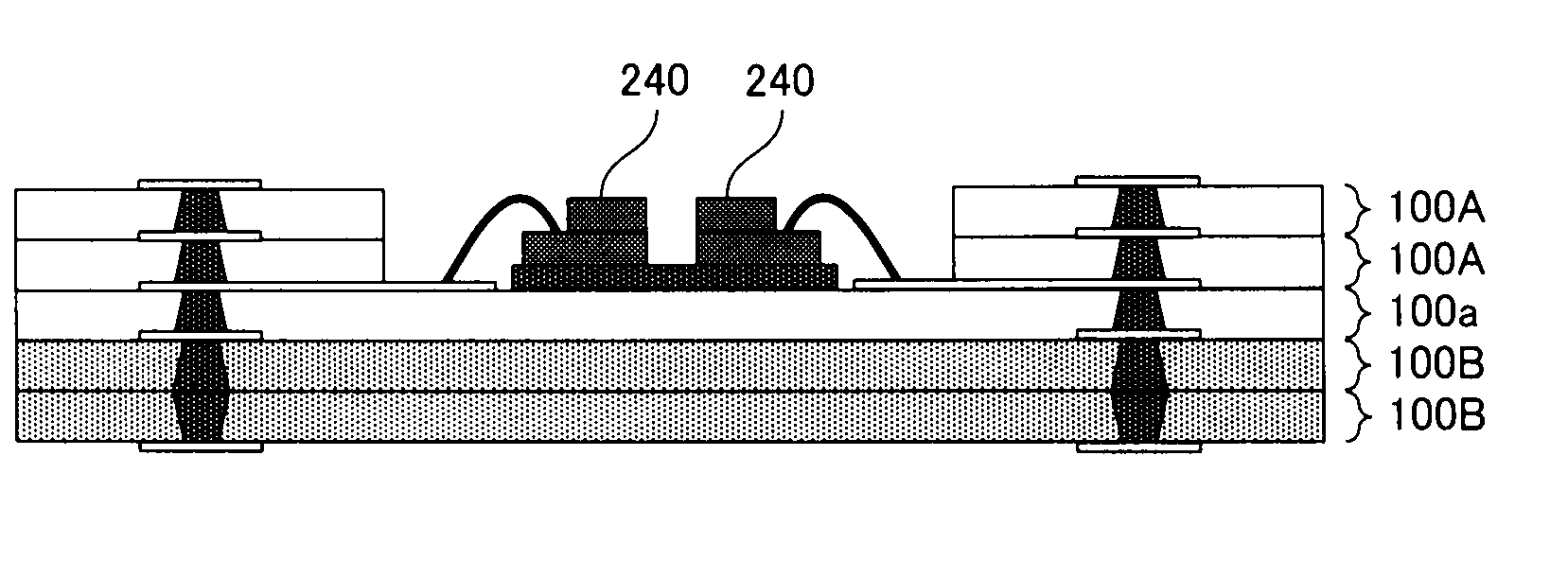Multilayer wiring substrate having cavity portion
a multi-layer wiring and cavity technology, applied in the field of semiconductor chips, can solve the problems of large-sized substrates, difficult to form thinner substrates, and cracks in ceramic substrates, and achieve the effect of low reflectance and low profil
- Summary
- Abstract
- Description
- Claims
- Application Information
AI Technical Summary
Benefits of technology
Problems solved by technology
Method used
Image
Examples
example 1
[0193](Production of the Wiring Substrate 100a)
[0194]A thermoplastic resin composition obtained by mixing: to 100 parts by mass of a resin mixture having: 40 mass % of a polyether ether ketone resin (PEEK 450G, Tm=335° C.), and 60 mass % of an amorphous polyetherimide resin (ULTEM 1000) ; 16 parts by mass of titanium oxide (average particle diameter of 0.23 μm, alumina treatment, silane coupling treatment) produced by chlorine method; and 45 parts by mass of a synthetic mica having an average particle diameter of 5 μm and an average aspect ratio of 50, was melt-kneaded, then the melt-kneaded resin composition was extruded into a film having a thickness of 100 μm simultaneously with lamination of a copper foil 22 from one side thereof, to obtain a one-sided copper-laminated insulating base material. Via holes each having a diameter of 100 μm were formed at predetermined positions using laser and a conductive paste composition was filled in the via holes by screen printing. After fill...
example 2
(Fabrication of the Multilayer Wiring Substrate 200A)
[0199]In the same manner as Example 1, the wiring substrate 100a and the wiring substrate (s) 100A were produced. With respect to the wiring substrates 100A, the first wiring substrate has a cavity hole 15 having the same size as that of Example 1 and the second one has a cavity hole 15 having slightly larger size. Thereafter, the two wiring substrates 100B were laminated at a lower side, the one wiring substrate 100a was laminated on the wiring substrates 100B along the bottom face of the cavity portion, the first wiring substrate 100A having the cavity hole 15 having the same size as that of Example 1 was laminated thereon, and finally, the second wiring substrate 100A having the cavity hole 15 having slightly larger size than that of Example 1 was laminated. By arranging a staircase-pattern polyimide resin-made spacer 260 having the same shape and thickness in the space to be the cavity portion 220, and by thermocompression bon...
example 3
(Production of the Wiring Substrate 100D)
[0200]A thermoplastic resin composition obtained by mixing: to 100 parts by mass of a resin mixture having: 65 mass % of a polyether ether ketone resin (PEEK 450G, Tm=335° C.), and 35 mass % of an amorphous polyetherimide resin (ULTEM 1000); 39 parts by mass of a synthetic mica having an average particle diameter of 5 μm and an average aspect ratio of 50, was melt-kneaded; and then the melt-kneaded resin composition was extruded into a film (i.e. insulating base material) having a thickness of 100 μm. After giving corona discharge treatment to both sides of the obtained film, a solution containing a polymerizable monomer prepared by mixing 50 mass % of dimethallyl bisphenol A and 50 mass % of bis(4-maleimidephenyl)methane was applied on a mold-releasable PET film and solidified by drying to form a 5 μm thick adhesive layer. Then, the adhesive layer was thermally transferred onto both surfaces of the insulating base material.
[0201]Then, via ho...
PUM
| Property | Measurement | Unit |
|---|---|---|
| wavelength range | aaaaa | aaaaa |
| reflectance | aaaaa | aaaaa |
| wavelength range | aaaaa | aaaaa |
Abstract
Description
Claims
Application Information
 Login to View More
Login to View More - R&D
- Intellectual Property
- Life Sciences
- Materials
- Tech Scout
- Unparalleled Data Quality
- Higher Quality Content
- 60% Fewer Hallucinations
Browse by: Latest US Patents, China's latest patents, Technical Efficacy Thesaurus, Application Domain, Technology Topic, Popular Technical Reports.
© 2025 PatSnap. All rights reserved.Legal|Privacy policy|Modern Slavery Act Transparency Statement|Sitemap|About US| Contact US: help@patsnap.com



